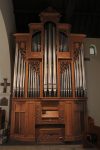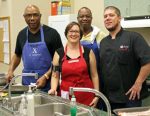An Altar or a Table?
There it is. It’s the central focus of our church. What is it? Is it an altar? Or is it a table? What we call it probably reflects our understanding of what goes on there.
I suspect that most American Christians today are more comfortable with a table than with an altar. An altar brings to mind grotesque images of some wild natives isolated in the darkness of a remote jungle offering a bloody sacrifice of an animal to placate an angry god. We’re much more comfortable with the image of a dining room table. At the dining room table we’re a friendly parish family gathered around the cozy table, just like our families at home, to share some good food and fellowship.
When the people of St. Andrew’s built this church back in 1904, they didn’t put a little table in the chancel. They had a strong suspicion that there was something more going on here. And so they built an altar. Perhaps if we knew why it is an altar rather than a table, we would better understand what we are participating in during Holy Communion. If we knew its origin, then we would know why it’s an altar.
I read of one man’s account of just how difficult it is to get back to the origin of things. He described how once he was walking through the streets of a Mexican village at dusk, when he heard the calm of the fading day shattered by the sound of an unearthly scream. Was it a child in pain? A dog in heat? No! On the back stoop of a simple stucco house, an old woman was calmly wringing a chicken’s neck. It was suppertime and she was preparing the family’s evening meal. In a short time it would be ready to be eaten at her family’s table.
Now, compare her children who were standing in the doorway watching this bloody slaughter with our children who think that their fried chicken comes from a kindly old Kentucky colonel with a white goatee. There’s something to be said for the mother who let her children see the real origin of their dinner. When they ate their chicken, it meant something much more to them than just a means to satisfy their appetites.
Our technological society insulates us from the truth of so much of life. Why? Perhaps because our world with all of its conveniences and pleasures is really the end product of a long line of suffering, toil, and pain. It’s not easy to live with the constant awareness of such misery staring us in the face. It is carefully concealed in plastic and cellophane, brightly colored wrappers, and cardboard packaging. If we can’t see it, we don’t think about it.
Perhaps that is why so many modern Christians, when they decide to build a church, shy away from building something like this high altar. A little wooden table set in the middle of the church is so much more “user-friendly.” At a dinner table there is harmony, unity, and pleasant conversation.
But at an altar the sounds are much more disturbing. One does not hear the polite table conversation of friends but the braying and screaming of beasts being slaughtered. At the table there is the coziness of family relationships. At the altar there is a cry of anguish as the beast sighs its last before the blade of death finally pierces its breast. At the table there is bread, wine, and the conviviality of good friendship. At the altar there is blood, carnage, and death.
When we see ourselves gathered only around a table instead of an altar, we forget the true origin of the eucharist. And it may be more than a matter of mere forgetfulness. Perhaps it’s the deliberate intention of those who don’t want to face the horror that is the origin of this sacred meal.
The real reason we gather in church is not just that we like each other’s company (although I hope that we do). It’s not just that we like to celebrate together (although that also may be true). No. We gather because we cannot forget the significance of which this important object reminds us. It was the death, not just of another beast, not just of another man … but of the Son of God.
What a strange lot we Christians are. We gather to worship our God gathered not around a garden of flowers, not under the sunny blue sky, not in view of a majestic mountain, not on a beautiful sandy beach. No, we gather around the place of death, a place that calls our attention to a life that was slaughtered. We must wonder what kind of God this is who invites us to meet him at such a place.
In tonight’s Old Testament lesson we see how God has always had a habit of doing things this way. We read of the instructions God had given to his people to celebrate the Passover. That annual eating, drinking, remembering, and praying was intended to remind the Israelites that it was by means of the bloody slaughter of that unblemished lamb whose blood was splattered on the door posts and lintels of their homes that they were spared death and delivered from bondage in Egypt. The Passover meal was a meal of death, the death of the lamb, the death of the Egyptian first born, the death of Pharaoh’s soldiers in the waters of the sea, deaths that ironically brought life and freedom to Israel.
The shadow of death also hangs heavy over Jesus and his disciples as they gathered for the Last Supper. It was the Passover Seder for which Jesus had gathered his apostles to eat on this dark and ominous night. Because we have the advantage of hindsight, we know that this was a meal of death in more than one way. A great horror was about to break out. Jesus was going to be betrayed by one right there in their midst. Jesus was going to be slaughtered like a sacrificial beast upon the altar, the altar of the cross.
Why? Why was such a bloody fate necessary for the Son of God? Why would there have to be the sacrifice of that unblemished lamb of the Passover?
The answer reveals a truth we so often want to avoid and ignore. He died because he came to bear the sin of the world. But like the chicken we conveniently pop into our mouths at the colonel’s, we don’t realize all the brutal bloodletting it took to get it there.
Jesus died because he became entangled in the maze of lies, fears, worries, hatreds, and sins that make up the fabric of human life. Jesus died because we all must die. No one likes to admit that our world is so flawed, so fallen, and so doomed. Hence the panic and hysteria surrounding the Coronavirus pandemic. But if the Son of God was to become like us in every way, then he had to suffer such a fate.
In Kurt Vonnegut’s novel, Slaughterhouse Five, during World War II a group of allied soldiers is captured and herded into a defunct meatpacking plant near Dresden, Germany. They are incarcerated in “Slaughterhouse Five.” Vonnegut vividly describes how the prisoners dread going into the dark basements of a place they could only associate with death. But the slaughterhouse no longer seems so cold and inhospitable. Sheltered deep in the basements of this house of death, Slaughterhouse Five ironically becomes a place of refuge and shelter when the fire-bombing of Dresden begins. The city above them was incinerated. But sheltered deep beneath the firestorm above, this place of death became a place of life.
Can we not say the same about this altar? Our church is built around the altar of death, a place that reminds us of the slaughter of Golgotha. We’re repelled by such a place not only because of the blood that was shed there by Jesus of Nazareth, but also because we’re reminded that it was because of us and our sin that such a bloodletting was ever necessary. Yet at the same time we’re drawn to this place. It’s a place of refuge and shelter for us in the midst of a world filled with pain and death and COVID-19.
The sacrifice has been accomplished. The judgment of God has been satisfied. For this meal commemorating Christ’s death is also the meal of life. So come and have a taste of eternity, a foretaste of the feast to come.
 St. Andrew’s Episcopal Church was established in Tampa in 1871. Its first service was held in the hospital building at Fort Brooke. A wooden church was erected in 1883 on the city block bounded by Marion, Twiggs, Morgan, and Madison.
St. Andrew’s Episcopal Church was established in Tampa in 1871. Its first service was held in the hospital building at Fort Brooke. A wooden church was erected in 1883 on the city block bounded by Marion, Twiggs, Morgan, and Madison. This history of the Windows of Saint Andrew’s is based upon research by the late Laban G. Lively. Additional information has been added by Nancy Turner. It is reconstructed for presentation on the WWW by Joe Daurril. Photos taken by Chris Cobb.
This history of the Windows of Saint Andrew’s is based upon research by the late Laban G. Lively. Additional information has been added by Nancy Turner. It is reconstructed for presentation on the WWW by Joe Daurril. Photos taken by Chris Cobb. The organ at St. Andrew’s Episcopal Church, Tampa, Florida, was designed and built by C. B. Fisk, Inc., of Gloucester, Massachusetts.
The organ at St. Andrew’s Episcopal Church, Tampa, Florida, was designed and built by C. B. Fisk, Inc., of Gloucester, Massachusetts. Ministry at St. Andrew’s is an integral part of our parish life and our community.
Ministry at St. Andrew’s is an integral part of our parish life and our community. St. Andrew's seeks to ensure that we are meeting the spiritual and religious education needs of all our members.
St. Andrew's seeks to ensure that we are meeting the spiritual and religious education needs of all our members.

 St. Andrew’s Episcopal Church was established in Tampa in 1871. Its first service was held in the hospital building at Fort Brooke. A wooden church was erected in 1883 on the city block bounded by Marion, Twiggs, Morgan, and Madison.
St. Andrew’s Episcopal Church was established in Tampa in 1871. Its first service was held in the hospital building at Fort Brooke. A wooden church was erected in 1883 on the city block bounded by Marion, Twiggs, Morgan, and Madison. This history of the Windows of Saint Andrew’s is based upon research by the late Laban G. Lively. Additional information has been added by Nancy Turner. It is reconstructed for presentation on the WWW by Joe Daurril. Photos taken by Chris Cobb.
This history of the Windows of Saint Andrew’s is based upon research by the late Laban G. Lively. Additional information has been added by Nancy Turner. It is reconstructed for presentation on the WWW by Joe Daurril. Photos taken by Chris Cobb.
 The organ at St. Andrew’s Episcopal Church, Tampa, Florida, was designed and built by C. B. Fisk, Inc., of Gloucester, Massachusetts.
The organ at St. Andrew’s Episcopal Church, Tampa, Florida, was designed and built by C. B. Fisk, Inc., of Gloucester, Massachusetts. Ministry at St. Andrew’s is an integral part of our parish life and our community.
Ministry at St. Andrew’s is an integral part of our parish life and our community. St. Andrew's seeks to ensure that we are meeting the spiritual and religious education needs of all our members.
St. Andrew's seeks to ensure that we are meeting the spiritual and religious education needs of all our members.